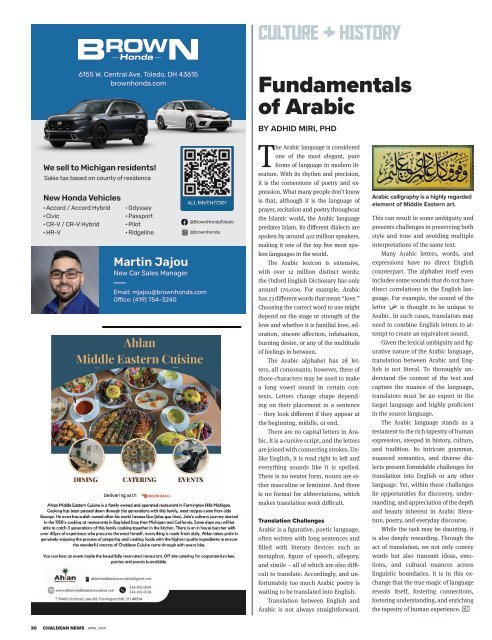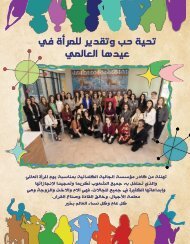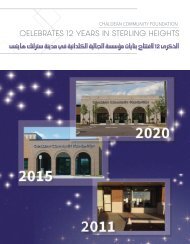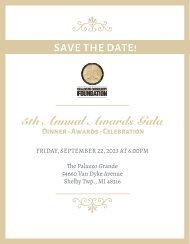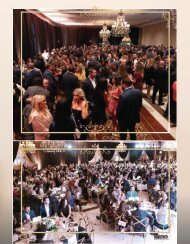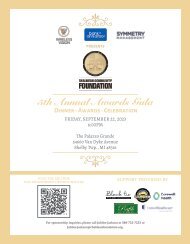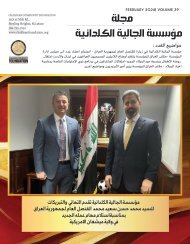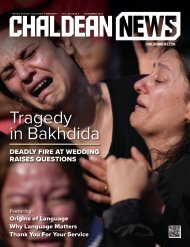You also want an ePaper? Increase the reach of your titles
YUMPU automatically turns print PDFs into web optimized ePapers that Google loves.
CULTURE & HISTORY<br />
6155 W. Central Ave. Toledo, OH 43615<br />
brownhonda.com<br />
Fundamentals<br />
of Arabic<br />
BY ADHID MIRI, PHD<br />
We sell to Michigan residents!<br />
Sales tax based on county of residence<br />
New Honda Vehicles<br />
• Accord / Accord Hybrid<br />
• Civic<br />
• CR-V / CR-V Hybrid<br />
• HR-V<br />
• Odyssey<br />
• Passport<br />
• Pilot<br />
• Ridgeline<br />
Martin Jajou<br />
New Car Sales Manager<br />
Email: mjajou@brownhonda.com<br />
Office: (419) 754-3240<br />
@BrownHondaToledo<br />
@brownhonda<br />
The Arabic language is considered<br />
one of the most elegant, pure<br />
forms of language in modern literature.<br />
With its rhythm and precision,<br />
it is the cornerstone of poetry and expression.<br />
What many people don’t know<br />
is that, although it is the language of<br />
prayer, recitation and poetry throughout<br />
the Islamic world, the Arabic language<br />
predates Islam. Its different dialects are<br />
spoken by around 422 million speakers,<br />
making it one of the top five most spoken<br />
languages in the world.<br />
The Arabic lexicon is extensive,<br />
with over 12 million distinct words;<br />
the Oxford English Dictionary has only<br />
around 170,000. For example, Arabic<br />
has 23 different words that mean “love.”<br />
Choosing the correct word to use might<br />
depend on the stage or strength of the<br />
love and whether it is familial love, adoration,<br />
sincere affection, infatuation,<br />
burning desire, or any of the multitude<br />
of feelings in between.<br />
The Arabic alphabet has 28 letters,<br />
all consonants; however, three of<br />
those characters may be used to make<br />
a long vowel sound in certain contexts.<br />
Letters change shape depending<br />
on their placement in a sentence<br />
– they look different if they appear at<br />
the beginning, middle, or end.<br />
There are no capital letters in Arabic.<br />
It is a cursive script, and the letters<br />
are joined with connecting strokes. Unlike<br />
English, it is read right to left and<br />
everything sounds like it is spelled.<br />
There is no neuter form, nouns are either<br />
masculine or feminine. And there<br />
is no format for abbreviations, which<br />
makes translation work difficult.<br />
Translation Challenges<br />
Arabic is a figurative, poetic language,<br />
often written with long sentences and<br />
filled with literary devices such as<br />
metaphor, figure of speech, allegory,<br />
and simile – all of which are also difficult<br />
to translate. Accordingly, and unfortunately<br />
too much Arabic poetry is<br />
waiting to be translated into English.<br />
Translation between English and<br />
Arabic is not always straightforward.<br />
Arabic calligraphy is a highly regarded<br />
element of Middle Eastern art.<br />
This can result in some ambiguity and<br />
presents challenges in preserving both<br />
style and tone and avoiding multiple<br />
interpretations of the same text.<br />
Many Arabic letters, words, and<br />
expressions have no direct English<br />
counterpart. The alphabet itself even<br />
includes some sounds that do not have<br />
direct correlations in the English language.<br />
For example, the sound of the<br />
letter ‘ ’ is thought to be unique to<br />
Arabic. In such cases, translators may<br />
need to combine English letters to attempt<br />
to create an equivalent sound.<br />
Given the lexical ambiguity and figurative<br />
nature of the Arabic language,<br />
translation between Arabic and English<br />
is not literal. To thoroughly understand<br />
the context of the text and<br />
capture the nuance of the language,<br />
translators must be an expert in the<br />
target language and highly proficient<br />
in the source language.<br />
The Arabic language stands as a<br />
testament to the rich tapestry of human<br />
expression, steeped in history, culture,<br />
and tradition. Its intricate grammar,<br />
nuanced semantics, and diverse dialects<br />
present formidable challenges for<br />
translation into English or any other<br />
language. Yet, within these challenges<br />
lie opportunities for discovery, understanding,<br />
and appreciation of the depth<br />
and beauty inherent in Arabic literature,<br />
poetry, and everyday discourse.<br />
While the task may be daunting, it<br />
is also deeply rewarding. Through the<br />
act of translation, we not only convey<br />
words but also transmit ideas, emotions,<br />
and cultural nuances across<br />
linguistic boundaries. It is in this exchange<br />
that the true magic of language<br />
reveals itself, fostering connections,<br />
fostering understanding, and enriching<br />
the tapestry of human experience.<br />
30 CHALDEAN NEWS <strong>APRIL</strong> <strong>2024</strong>


